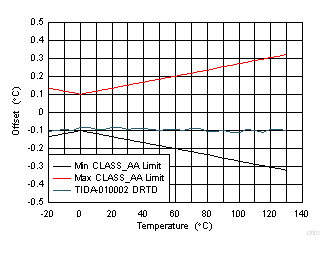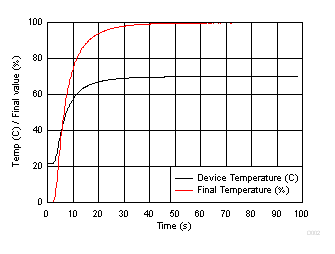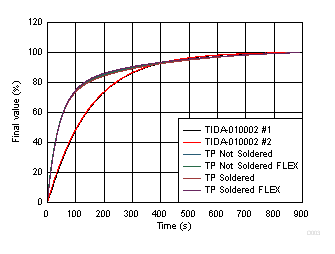TIDUEA0A March 2019 – September 2020
- Description
- Resources
- Features
- Applications
- 5
- 1System Description
- 2System Overview
-
3Hardware, Software, Testing Requirements, and Test Results
- 3.1 Required Hardware and Software
- 3.2
Testing and Results
- 3.2.1 Test Setup for Performance Testing
- 3.2.2 EMI and EMC Test Requirements for DRTD
- 3.2.3 TMP117 EMI/EMC Test Results
- 3.2.4 TMP117 Based Temperature Probe Measurement Performance Test Results
- 3.2.5 TMP116 Based Temperature Probe Measurement Performance Test Results
- 3.2.6 I2C-bus Cable Length Considerations
- 3.2.7 Power Supply
- 3.2.8 ESD Test Results for TMP116
- 3.2.9 Summary
- 4Design Files
- 5Software Files
- 6Related Documentation
- 7About the Author
- 8Revision History
3.2.5 TMP116 Based Temperature Probe Measurement Performance Test Results
Similar to the TMP117 probe, our TMP116 DRTD probe was immersed into the precision Fluke oil bath with Galden HT200 oil. The temperature offset graph is shown in Figure 3-8.
 Figure 3-8 TMP116 DRTD -20 to 130C Temp. Error Drift
Figure 3-8 TMP116 DRTD -20 to 130C Temp. Error DriftNote that the Class AA accuracy achieved with this TIDA-010002 DRTD unit without calibration is not guaranteed for all TMP116 devices by default.The DTRD probes using the TMP117 and TMP116 both achieve class AA accuracy and the offset values between the two probes are very similar as expected.
Similar to Section 3.2.4, respose time was measured in both stirred oil and still air. In Figure 3-9, the DUT has initial temperature of 20.5°C and is inserted into a 70°C hot oil bath and the DUT reported temperature has been logged. The response time in the oil bath between the TMP117 and TMP116 probes is very similar; it takes approximately 55 seconds for the probes to reach the oil temperature of 70°C.
 Figure 3-9 TMP116 DRTD Response Time in Stirred Oil Bath
Figure 3-9 TMP116 DRTD Response Time in Stirred Oil BathThe still air response time of two DRTD probes, named DUT1 and DUT2, is shown in Figure 3-10 and also compared to other TI test boards with the TMP116 thermal pad either soldered or not soldered. Obviously, the DRTD probes with their metal sheath and much larger thermal mass have a longer response time but after a delay of approximately 400 seconds they are equal to a bare PCB with TMP116. TP means Thermal Pad and tests have been made to compare the performance with and without soldering the thermal pad (for details see Precise Temperature Measurements with TMP116).
 Figure 3-10 TMP116 DRTD Response Time in Still Air
Figure 3-10 TMP116 DRTD Response Time in Still Air